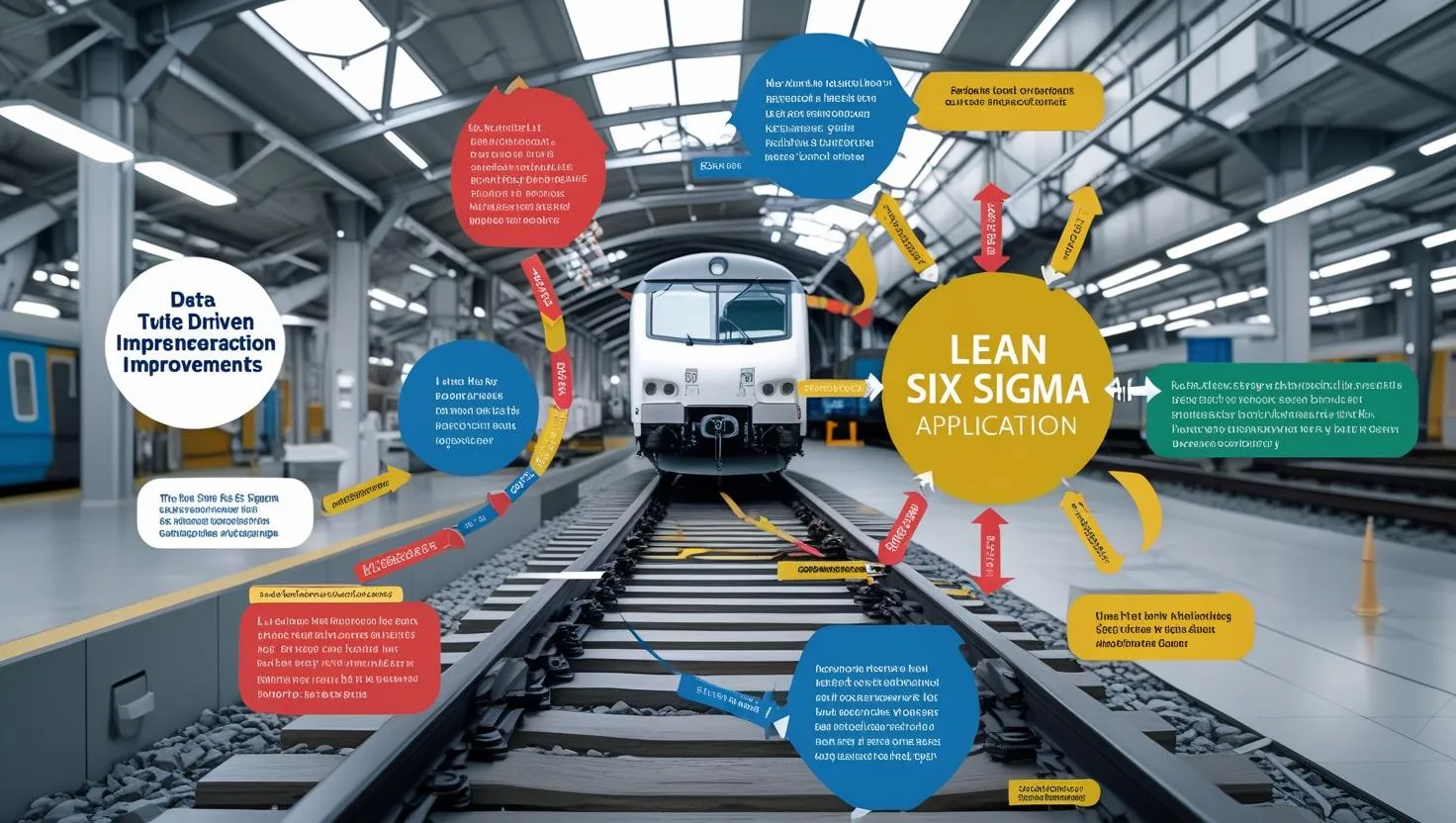Lean Six Sigma Application in Railways: Improving Efficiency and Quality

Effectiveness and quality are the success keys of all businesses in the contemporary world. As a transport backbone, the railway industry is most vulnerable to dozens of operation inefficiencies, security risks, and customer dissatisfaction. In answer to all these, organizations worldwide are adopting models such as Lean and Six Sigma—two influential frameworks whose concurrent use results in a model of successful process improvement and operational excellence.
Here in this blog, we will get a clearer understanding of how Lean Six Sigma can be best utilized in the rail industry to enhance efficiency, reduce costs, and enhance customer satisfaction.
What is Lean Six Sigma?
Let us first understand what Lean and Six Sigma are and how they supplement one another before moving on to its implementation in railways:
• Lean emphasizes reducing waste in processes to make procedures simpler and increase the speed. The majority of value is to be delivered through fewer resources and minutes.
• Six Sigma, however, is a data-driven methodology whose vision is to improve process quality by eliminating and defects and variations. It aims for nearly perfect processes with fewer errors.
Through blending the strengths of the two methodologies, Lean Six Sigma strives for greater efficiency at a lower cost in terms of quality.
Challenges in the Railway Sector
The railway network is the backbone of the economies of nations, moving millions of products and people every day. Its operation, nonetheless, is marked by a multitude of challenges:
- Operational Inefficiencies: Mismanagement, delay, and breakdown lead to loss of resources and time.
- High Maintenance Costs: Railway infrastructure, rolling stock, and signaling equipment are in constant need of maintenance that is often expensive and time-consuming.
- Safety Issues: Passenger and freight safety are accorded highest priority. Variability in process might cause accidents and failure of operation.
- Customer Satisfaction: Customers demand more reliability, comfort, and punctuality. Low response rate, inferior facilities and poor services quality typically lead to dissatisfaction.
Lean Six Sigma is well-positioned to solve these problems by providing an official procedure for process improvement, waste reduction, and quality improvement.
How Lean Six Sigma Can Be Applied in Railways

1. Reducing Delays and Improving Timeliness
Delays are the most common issue in railway industry, and they are more expensive, result in missed connections, and create frustration among passengers. With the aid of Lean Six Sigma tools such as Value Stream Mapping (VSM) and Root Cause Analysis (RCA), railway companies can:
- Identify train operating schedules, maintenance operations, and bottlenecks in scheduling.
- Analyze delays and identify the root cause—whether they are associated with the signaling system, train schedule, or crew management.
- Enforce ongoing monitoring and enhance planning to minimize delays and enhance on-time delivery.
For instance, in Lean-based scheduling, the potential exists to eliminate waiting times or intermediate steps and achieve train movement either speedier or faster.
2. Enhancing Safety and Reducing Defects
Safety is always a top priority in the railway industry. Yet, process variation can result in mistakes, accidents, or equipment breakdowns. Through Six Sigma’s DMAIC approach—Defining problems, Measuring current performance, Analyzing data, Improving processes, and Controlling outcomes—railroads are able to:
• Define key safety measures like accident rates, equipment failure rates, and response times.
• Measure current safety performance in an attempt to establish baselines.
• Analyze data to identify where correction is required and where there might be potential harm.
• Improve processes for reducing task variability and error, e.g., signal training or station inspection.
• Control security levels by the use of close monitoring programs and establishing security protocols.
Six Sigma’s approach of analysis ensures that railway industries are able to measure defects correctly and eradicate them, reducing accidents and making travel safer for passengers along with employees.
3. Optimizing Maintenance and Reducing Costs
One of the largest expenses in railway sector is for maintenance. Tracks, locomotives, signal systems, and other equipment have to be inspected and rebuilt periodically at great cost. In Lean Six Sigma:
• Monitoring systems and information in real-time can be leveraged to take benefit from predictive maintenance techniques. This assists rail companies in identifying problems before they become significant issues, reducing downtime and unnecessary repairs.
• Root cause analysis facilitates the identification of the root cause of recurring failure or breakdowns, whether the result of equipment aging, operation errors, or poor maintenance practice.
• Reduction of maintenance waste by means such as elimination of unnecessary checks or repair sequence optimization can be cost-free and attain or improve equipment reliability delivery.
With the focus on these dimensions, Lean Six Sigma allows railway companies to transition from reactive to productive and predictive maintenance.
4. Improving Customer Experience
Customer satisfaction is the utmost concern of the railway sector. The Passengers are seeking timely arrival, efficient service, hygienic stations, and pleasant trips. Lean Six Sigma can create overall improvement in customer satisfaction in a variety of ways:
• Service Quality Enhancements: By process mapping and customer complaint analysis, companies can identify segments of service delivery that can be enhanced, such as ticket booking, station amenities, and onboard services.
• Waiting Time Reduction: Lean philosophy is applied to minimize check-in time, ticketing, and baggage handling. Waiting time reduction has a direct impact on customer satisfaction.
• Personalization: Passenger data can be processed to provide personalized services, promotions, or reward points.
Through continuous customer feedback monitoring and the use of Lean Six Sigma to reduce waste, railroad firms are able to enhance the traveling experience significantly.
Key Tools of Lean Six Sigma for Railways
There are some Lean Six Sigma tools that may be utilized in an attempt to effectively enhance rail operations. Some of the best tools include:
• Kaizen: An ongoing improvement process by gradual small steps in an attempt to enhance efficiency in the long term.
• Fishbone Diagram (Ishikawa): A tool utilized in an attempt to identify the root cause of problems and enact effective solutions.
• Pareto Analysis: Allows for prioritization through the identification of most critical problems leading to delay, breakdown, or inefficiency.
• Control Charts: For monitoring long-term process performance and consistent operation.
• FMEA (Failure Modes and Effects Analysis): Helps to spot where failures are likely to happen in systems and processes to avoid accidents or failure.
Benefits of Lean Six Sigma in Railways
- Enhanced Operational Efficiency: Reduced wastage and process simplification enable railway transport operations to become cost and time-efficient.
- Enhanced Safety: Reducing defects and variation lead to safer and more dependable crew and passengers.
- Cost Savings: Cutting out the inefficiencies of maintenance, reducing delays, and optimizing processes realize gigantic cost savings.
- Customer Satisfaction: Lean Six Sigma emphasis on continuous improvement results in a more satisfying customer experience, and hence increased satisfaction and loyalty.
- Data-Based Decisions: The focus on data in the methodology guarantees decisions are based on facts, resulting in best solutions
Conclusion
The railroad industry with its complexities and magnitude can immensely benefit through Lean Six Sigma’s implementation. Be it improvement of safety culture, process excellence in maintenance or even customer satisfaction, this comprehensive methodology is the solution to several issues that challenge rail in modern times.
Through the implementation of Lean Six Sigma methods, rail companies are able to further develop on the path of operational excellence, reducing costs, improving the quality of service, and offering security to its commuters. The result is a better, better, and more reliable rail system—a system that can cope with the demands of the time.
